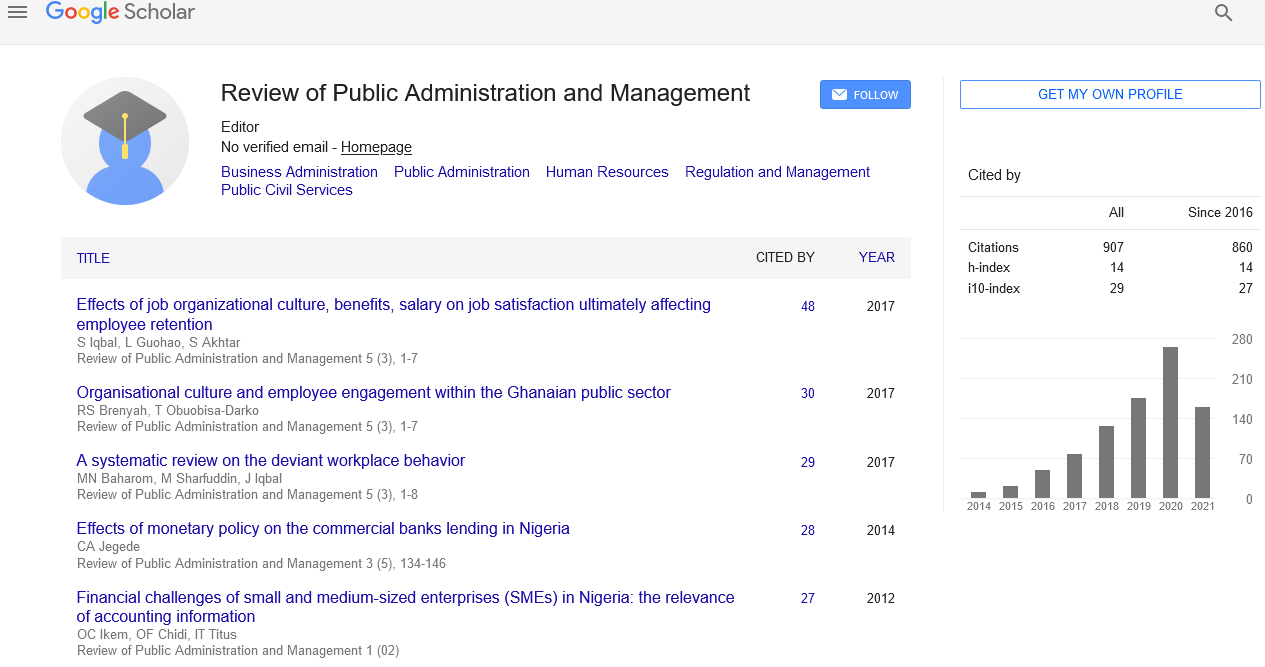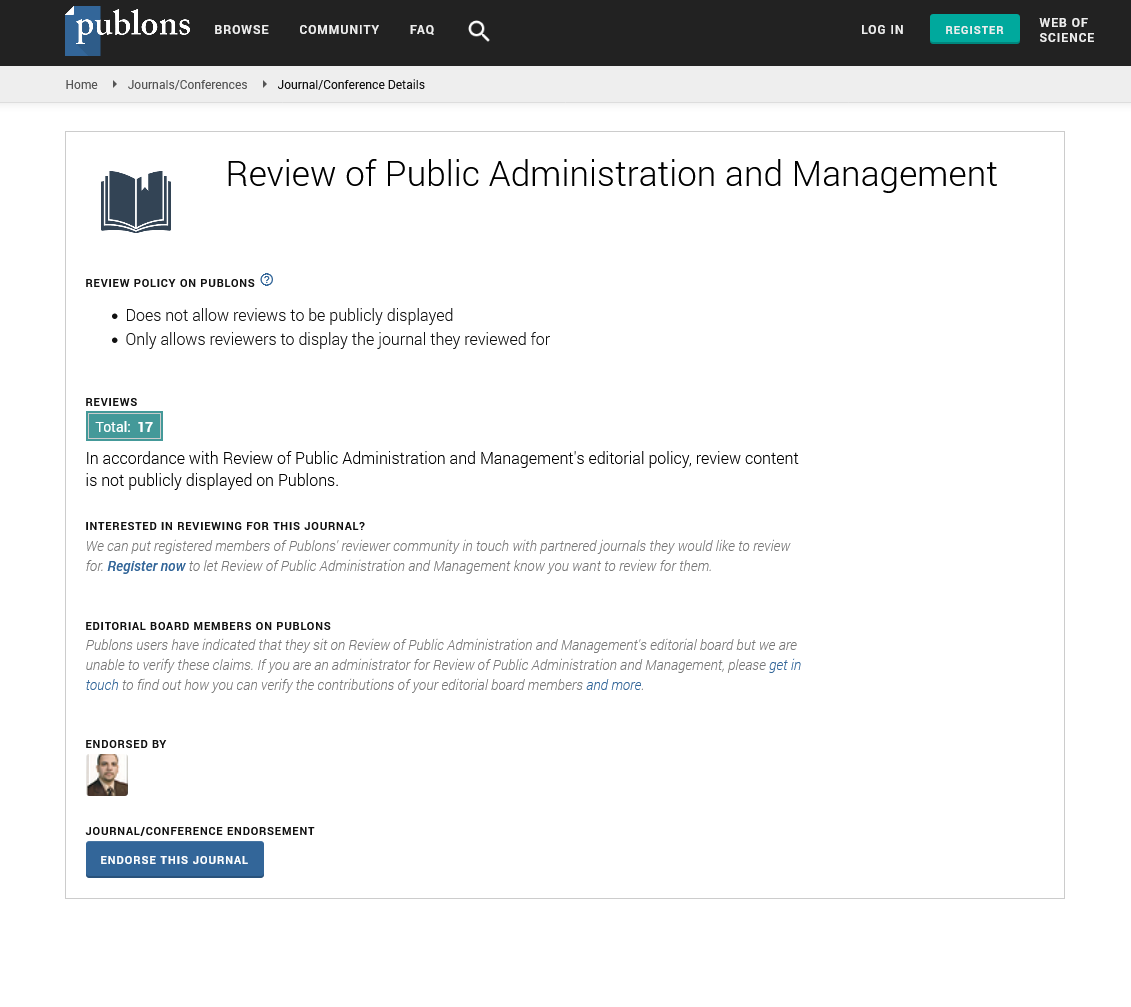Indexed In
- CiteFactor
- RefSeek
- Directory of Research Journal Indexing (DRJI)
- Hamdard University
- EBSCO A-Z
- Scholarsteer
- Publons
- Euro Pub
- Google Scholar
Useful Links
Share This Page
Journal Flyer

Open Access Journals
- Agri and Aquaculture
- Biochemistry
- Bioinformatics & Systems Biology
- Business & Management
- Chemistry
- Clinical Sciences
- Engineering
- Food & Nutrition
- General Science
- Genetics & Molecular Biology
- Immunology & Microbiology
- Medical Sciences
- Neuroscience & Psychology
- Nursing & Health Care
- Pharmaceutical Sciences
Commentary - (2025) Volume 13, Issue 1
Women in Public Administration: Representation and Policy Impact
Aiko Nakamura*Received: 24-Feb-2025, Manuscript No. RPAM-25-29225; Editor assigned: 26-Feb-2025, Pre QC No. RPAM-25-29225; Reviewed: 12-Mar-2025, QC No. RPAM-25-29225; Revised: 18-Mar-2025, Manuscript No. RPAM-25-29225; Published: 26-Mar-2025, DOI: 10.35248/2315-7844.25.13.482
Description
In recent decades, the global discourse around gender equality and inclusive governance has brought renewed attention to the role of women in public administration. As key players in shaping policy, delivering public services and ensuring democratic accountability, women in public administration are essential to building equitable, responsive and inclusive institutions. Increasing their representation is not only a matter of justice and equality but also a strategic imperative for effective governance. Numerous studies have shown that gender-diverse leadership leads to more balanced decision-making, greater social equity and improved policy outcomes. Despite this, women remain underrepresented in senior public service positions across many regions, particularly in developing countries. This imbalance reflects deep-rooted societal, cultural and institutional barriers that limit women’s full participation in public governance.
The representation of women in public administration varies widely across countries and administrative levels. In some developed nations, women make up a significant portion of the civil service, particularly at mid and junior levels. However, the "glass ceiling" often prevents them from rising to leadership roles such as department heads, permanent secretaries, or cabinet-level bureaucrats. In many developing nations, the gender gap is more pronounced, with low female participation due to social norms, lack of education, limited career mobility and political exclusion. Although legal frameworks and affirmative action policies have made some progress such as gender quotas, equal employment laws and leadership development programs, the pace of change remains uneven and slow in many areas.
The underrepresentation of women in public administration affects not only institutional diversity but also the policy priorities and outcomes that governments pursue. Women administrators often bring different experiences, perspectives and leadership styles, which influence how policies are formulated and implemented. Research has shown that female public servants are more likely to prioritize social issues such as healthcare, education, family welfare, gender-based violence and community development. Their presence helps ensure that policies are more inclusive and sensitive to the needs of marginalized groups, particularly women and children. Moreover, women’s participation fosters greater transparency and accountability, as female administrators are often perceived as less corrupt and more responsive to citizens' concerns.
Leadership styles between men and women in public administration also tend to differ. Female leaders are frequently characterized by collaborative, participatory and empathetic approaches to governance. These styles can enhance organizational culture, improve employee morale and increase responsiveness in public service delivery. For example, women in leadership roles are often more likely to engage communities in decision-making, value consensus and implement people-centric policies. This aligns closely with the goals of good governance, which emphasize transparency, citizen engagement and evidence-based policy development.
Despite these positive impacts, the road to achieving gender parity in public administration is fraught with challenges. Structural and institutional biases, often embedded in recruitment, promotion and evaluation systems, continue to hinder women’s advancement. Women are frequently overlooked for leadership roles due to gender stereotypes, lack of mentorship opportunities and assumptions about their commitment to work, especially if they have caregiving responsibilities. Furthermore, public sector work environments may lack adequate policies for work-life balance, childcare support and protections against harassment, all of which disproportionately affect female employees.
Another significant barrier is the lack of political and social support for women in decision-making roles. Even where legal provisions exist to promote gender equality, societal attitudes often lag behind. Women in leadership positions may face resistance, scrutiny, or even hostility, particularly in male-dominated environments. To overcome this, it is essential to foster a supportive institutional culture that values diversity and actively promotes gender-sensitive policies within the bureaucracy.
To improve representation and impact, governments and public institutions must adopt targeted strategies. These include affirmative action measures such as quotas in civil service recruitment, gender-sensitive performance evaluation systems, leadership training programs and mentorship networks. Additionally, institutional reforms that ensure equal pay, maternity and paternity leave and protection from workplace discrimination are necessary to create enabling environments. Some countries have shown notable progress; Rwanda, for instance, has one of the highest rates of female representation in public office, supported by constitutional guarantees and strong political commitment.
Capacity building and education are equally vital for ensuring women's sustained participation in public administration. Encouraging girls and young women to pursue careers in public policy, law, governance and management can build a future pipeline of qualified female leaders. Gender mainstreaming in administrative training and professional development programs can also sensitize all public servants to the importance of inclusive governance and equip women with the skills needed to ascend to leadership roles.
Citation: Nakamura A (2025). Women in Public Administration: Representation and Policy Impact. Review Pub Administration Manag.13: 482.
Copyright: © 2025 Nakamura A. This is an open access article distributed under the terms of the Creative Commons Attribution License, which permits unrestricted use, distribution and reproduction in any medium, provided the original author and source are credited.


